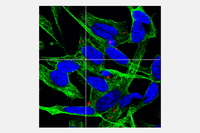On the tracks of SARS-CoV-2 in neuroblastoma and glioblastoma cell lines
Students working side-by-side with NARILIS researchers
Although SARS-CoV-2 mainly affects the lower respiratory tract, a minority of patients develop severe forms with multi-organ injury. Given that the entry receptor ACE2 for SARS-CoV-2 is expressed in multiple tissues, it is plausible that this pathogen may have the ability to disseminate to extrapulmonary sites. Prof. Charles Nicaise (UNamur, URPhyM, Laboratory Neurodegeneration and Regeneration) therefore decided to dig deeper into the neuroinvasive potential of SARS-CoV-2. His lab teamed up with the research group of Prof. Nicolas Gillet (UNamur, Integrated Veterinary Research Unit) to study the susceptibility of neural cell lines towards SARS-CoV-2 infection.
Researchers infected neuroblastoma and glioblastoma cell lines with a SARS-CoV-2 strain isolated from a Belgian COVID-19 patient in the UNamur BL3 facility. Their findings have just been published in Brain Research (Bielarz et al., 2021) and confirm that SARS-CoV-2 has a tropism for neural cells. These neuron-like and glial-like cells might thus be useful tools to further decipher entry, replication and cytopathic effects of SARS-CoV-2 in the central nervous system.
Alongside NARILIS researchers, several UNamur students from the faculties of Medicine and Sciences were get involved in this unique research project. Noémie Avalosse, third year bachelor's student in Biomedical sciences, and Riselane Lotfi, third year bachelor's student in Veterinary medicine, actively contributed to the experimental work and therefore greatly deserved to be cited as co-authors of the publication.
Furthermore, on March 18, our research-students will be presenting their work on SARS-CoV-2 neurotropism during an online conference given by the UNamur in the framework of the Brain Awareness Week 2021. The goal of this global campaign is to increase public awareness of the progress and benefits of brain research. At this occasion, Charles Nicaise will review COVID-19 extrapulmonary manifestations, the COVID-19–associated cytokine storm and the neurological injuries observed in severe forms of the disease.
 NAmur Research Institute for LIfe Sciences
NAmur Research Institute for LIfe Sciences


